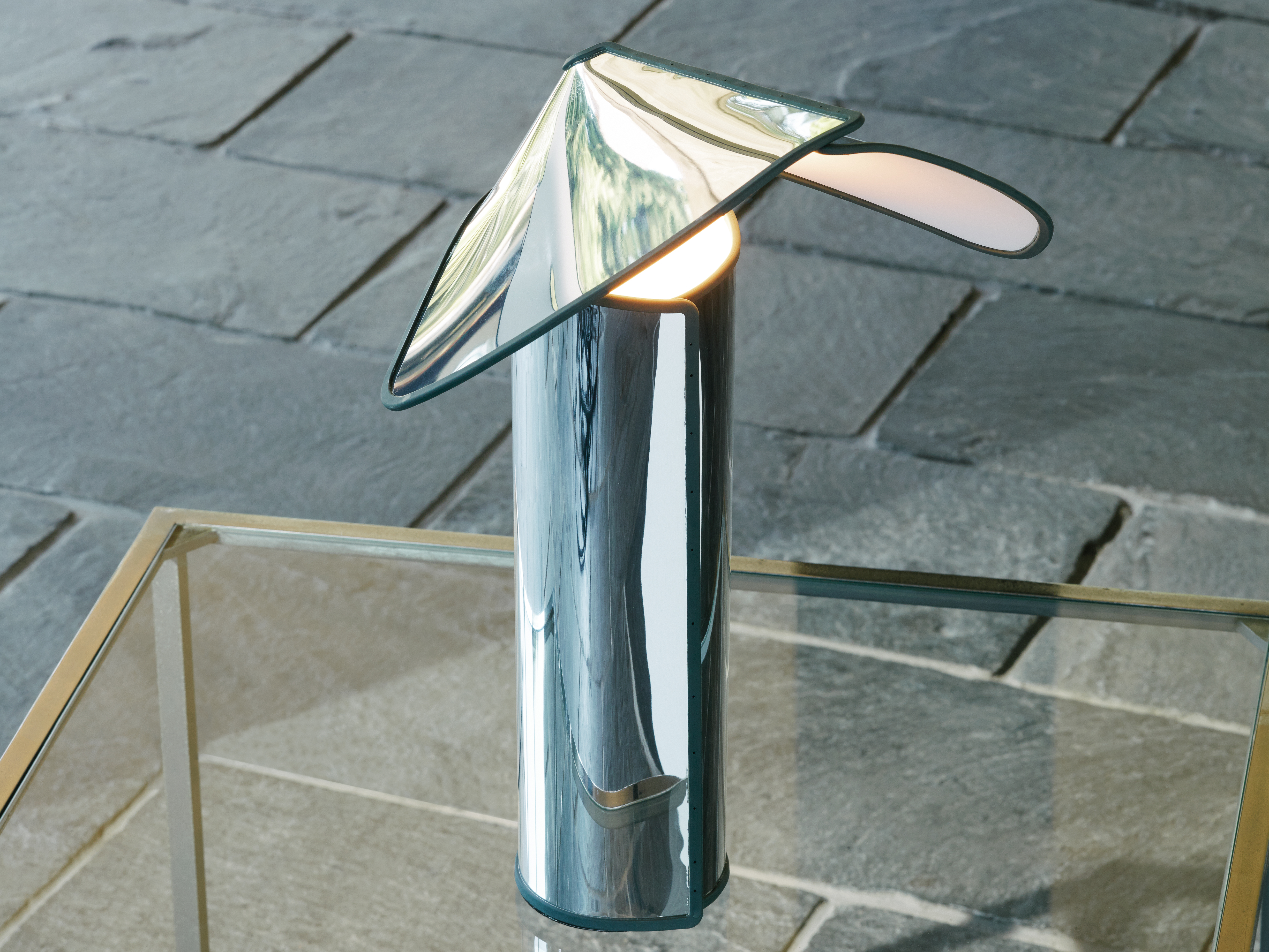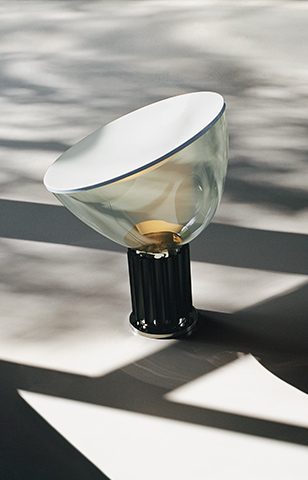Mario Bellini and Chiara
In 1969, Italian architect Mario Bellini debuted Chiara, a flat-packable floor lamp for Flos that wore a shiny cloak of stainless steel. Fifty years after its introduction, Flos is reissuing the icon in a range of sizes and finishes. To honour the occasion, Flos design curator Paolo Brambilla talks with the legend about what inspired Chiara, how design has changed since the ‘60s, and how it hasn’t.
Product Chiara - Designer Mario Bellini - Director Michele Foti - Photography Alessandro Furchino Capria, Federico Torra, Piero Fasanotto, Giuseppe Pino - Interview Paolo Brambilla - From Flos Stories Issue 2
PAOLO BRAMBILLA: How did Chiara come about?
MARIO BELLINI: One day in my studio it came to me that we could use light the way it manifests in our surroundings and our landscapes—never directly, but often through clouds or reflected off objects, walls, and surfaces. And so, instead of saying ‘let’s design a lamp’, I said, ‘let’s design an apparatus that can take light from an artificial source and send it back into our surroundings with a certain intelligence and grace’. Thinking about it was the easy bit, but then came the more difficult part: what do you do in a case like this? I took some scissors, a big piece of card, and I started to cut out something that could be made into a cylinder with a wide hat on top that, when joined on the right and left-hand side, would act as a reflector of the light source housed in the base. And that was it.
PAOLO BRAMBILLA: The lamp is called Chiara, which means clear, but it actually refers to something completely different.
MARIO BELLINI: I always like to play around with words and their meanings. I am also a lover of etymology. Chiara means something clear, but the word clear is a word we use an awful lot in our language (‘let’s be clear’; ‘let’s clear this up’), and there are also certain Lombardy dialectal expressions for ‘to shed light’ that use the Italian word chiaro. Chiara is also the name of one of my daughters.
"I took some scissors, a big piece of card, and I started to cut out something that could be made into a cylinder with a wide hat on top that, when joined on the right and left-hand side, would act as a reflector of the light source housed in the base."
PAOLO BRAMBILLA: When you created this lamp, I imagine you designed it with Sergio Gandini. How did this relationship with Flos start?
MARIO BELLINI: Back then, it was possible to make something and then ask for an appointment to show your project, as I did with the card cut-out I mentioned earlier. You spoke with a person who said they were willing to have a look and try it, and this is what happened. From that piece of card we moved on to a big sheet of stainless steel that was cut so it would wrap around into a cylinder, with three cuts on the bottom edge corresponding to three rings that acted as a lamp stand into which the bulb was screwed. On top there was a hat that extended beyond the edges, tilted at 45 degrees. This was the forerunner for what we are now restudying and putting back into production, even designing a family of different sizes and performance around it. It’s not just a simple re-edition; we are doing something that had never really worked out: the original Chiara had a decorative profile on the edge of the sheet steel which was a hazard for anyone touching it—it wouldn’t stay attached. Finally, we managed to make this edging so that it stays permanently fixed to the metal and, given the occasion, we have also had fun building a family of Chiaras: the classic Chiara with a few new details and differences, a medium-sized Chiara, and a small Chiara that is suitable for standing on a dressing table, a shelf, or a low piece of furniture. If you’re reading in bed, this Chiara will shine light on your newspaper or book without harming your eyes.
PAOLO BRAMBILLA: Chiara, like many other objects you’ve designed, has become an icon. Those were the heroic years, when everything was still waiting to be invented. How is the design landscape different today?
MARIO BELLINI: Today design has become a popular word. We say, ‘I see you’ve got yourself a design home’, and that makes me ask so many questions. What on earth does ‘design home’ mean? If design means project, having a designed home does not make sense. I actually forecast that the word design would end up meaning, not just the simple idea of a project, but the indicator of a style, like, for example, Art Deco. When we spoke of design in those years, we thought we were making a statement. Now, they say that the era of styles is over, that now form follows function. But form has almost always followed function, otherwise millennia ago we would have managed to design a chair on which not to sit. But form also follows emotion, meaning, and values. Take a lamp like Chiara—think in how many other ways you can deflect light and send it back in a certain direction. Instead, this little character that has become an icon over time not only reflects the light that is inside its cylindrical part, diffusing it gracefully into its surroundings, but it also has a gratifying look and presence. Chiara itself fills space and addresses your emotional capacity to interpret things.
PAOLO BRAMBILLA: Will icons continue to exist? Where are we headed today?
MARIO BELLINI: The idea that the time has come when styles are finished is an idiotic one, without any historic, philosophical foundation or awareness. And I am pleased that this is the case and that design is a style. Those who are talented enough to design furnishings, objects, interiors, and homes, will continue to do so. Only projects designed by those using this talent will become icons. Things designed that represent our time and how it evolves, that lend meaning to our homes, our living spaces, and our offices, will gradually change and evolve. So when I say ‘design style’ I mean, somewhat controversially, that although this word was used to mark the end of styles, paradoxically it has actually ended up by becoming, quite rightly, the style of our times. And so it will be remembered in a hundred years’ time.
PAOLO BRAMBILLA: How has design changed in private spaces in recent years? How has our way of living changed?
MARIO BELLINI: If the question is how and if our way of living has changed, I want to immediately distinguish: the way we live, our offices, and how we co-live in our homes has changed radically. I once did a lot of research into the phenomenon of office work. I even wrote a book entitled Office Project, in which I said that the importance of being in a workspace consists of realising that you spend eight hours in this space, sitting on this chair at this so-called desk, and so much more attention should be paid to these furnishings. At that time we used the expression ‘office landscape’, and this was seen as an extraordinary innovation, but often the only response to this intuition was to add another plant or an extra screen. The real solution is not adding greenery, but ensuring that your office is a space for your entire person, not just your job. Even when you are in the office, you are living. Your chair must be comfortable. What you see around you as landscape must not be a functional abstraction. For example, I imagined that those who spent time in this space must be able to enjoy watching all those who walk past. Boring, maybe, but they must feel they are a part of a whole. Additionally, when someone comes to their workstation to have a chat, they normally find a barrier before them, invented by some genius to hide the secretary’s legs. But it prevented anyone from sitting in front of you at your desk. As a result, anyone who came to talk to you at your desk had to sit at the corner with the point of the surface in their stomach. So I invented a round attachment to add to normal, rectangular desks that I christened Planet Office. Within a month this round attachment became the must-have accessory for all office systems then in production. Everyone adopted it. I didn’t get angry because I said to myself, ‘Perhaps I have invented something meaningful’, and the meaning was that when you are an important person, those coming to see you are people, not robots, and therefore, if they want to sit and talk to you they sit around this attachment. You move a bit and your attention is focused on them. All of this was fundamental for the innovation of office space.
PAOLO BRAMBILLA: Even in our homes, the arrival of technology, especially over recent years, has changed our lifestyles, no?
MARIO BELLINI: I will pose a slightly controversial question: are we sure we are living in a different way from how the ancient Romans lived? I would say not. Go and see what excavation is revealing—they had courtyards, with covered walkways and columns, a pool of water, greenery, houses had two storeys with stairs, there were windows inside, corners where they cooked and, if they cooked, there were pans, fire, fish, etc.
And there were sofas to sit on, more like Trimalcione than nowadays, more comfortably seated. Most activities and things that they used then were the same as today, because while passing from the Roman era to today, we haven’t changed, we still have two legs, two arms, two hands, two feet, two eyes, the same intelligence. Our culture is very similar to theirs—their philosophers and literati still form the basis for European and western culture. So we need to watch what we mean when we say evolution and changes. It is also clear that everything changes because we fly in planes, we take the underground, we drive around in cars. But, you know, before the car there was the horse, there were carriages, it was the same thing. Ladies would take their carriages to show off their clothes at tea time. There’s this wonderful, really interesting novel by Marco Romano called La Città Delle Donne (The City of Women).
PAOLO BRAMBILLA: So if our home lifestyles are not changing what sense is there in re-editing a lamp from 50 years ago?
MARIO BELLINI: On this scale of values we are talking about, fifty years is five minutes. And, therefore, a lamp, an object, a piece of furniture, etc. from then and now look very alike, unless we refer to elements and plants that have undergone violent evolution. But 50 years ago, cars already existed and still exist. Perhaps there are no more carriages, but carriages were the mothers of cars; horses were the mothers of motorbikes. Even I see that I almost exaggerate in considering the great permanence of how our civilisation lives. So let’s look at it slowly and think that perhaps every 10 or 20 years all the valves flip and everything turns over. We still have jackets and shirts and ties etc. These are things that, luckily, have had and continue to have an extremely long existence.




























